You're currently being redirected to volomir.com, it will only take a few moments.
This article is a compilation of the different articles I wrote on the High Elves as I was making them. Now you can read it in a single piece more easily. Enjoy.
Due to the release of Warhammer: Island of Blood and the new range of high elves, I've decided to build a little army of these little flower eaters, around the hero that is the elf prince of Tribute to the Fallen. First step will be a unit of sea guard from Island of Blood which I present you right now:

I don't really like the seadragon relief on the shields.

That's why I will get rid of them with the use of my dremmel. I will also erase the reliefs on the banner, as I prefer a freehand design instead of the relief thing.


Now I fill the holes on the shields with some milliput and sand them after they are dry to smooth the surface.

I also don't like how big the armour scales are. I believe they could have modelled an additional row of scales between every two of them. So, that's what I'll do next.

Also, I'll be sculpting some reliefs of my own on the shields. I would prefer to use the plain shields for some complete freehand work, but as this will be an entire unit, reliefs will make work faster. I just modelled one and then made a little green stuff press mould to repeat the relief in the rest of the shields. Now they will have a symbol to relate them to my Tribute to the Fallen prince!


Now that everything is finished, I will wash the pieces with some water and soap, to get rid of possible mould grease and putty dust. See them dry on my bath towel!

Now let's start with the painting. I will be painting one prototype first, in which I will not hesitate to spend a long time. Once I finish this prototype I will have clear knowledge of what I want my elves to look like and the colours to use, so I will be a lot faster with the rest.
My first approach will be to get this shield concept on the actual models.

The star and the wings will certainly resemble the prince from Tribute to the Fallen. Check out the lion in the background!

In this step I will leave the shield as it is now. Probably later, once I have more of the elf painted, I will come back to improve it and change stuff to get a better match for the whole painting.

And now I'll go on with the clothes and the metallic parts. I will try to use airbrush as much as I can as it will ease the painting process and also make the transitions smoother. I also do not hesitate to use metallic paint with the airbrush, it actually works more or less the same as with the other non metallic paints. The shades in the metal will be green/blue representing the reflection of the greens/blues from the clothes in the shiny elvish armour.




In the next step I have the prototype nearly finished. I've chosen a reddish tone for the hair which will contrast with the turquoise of the rest (actually, this fact has given me the idea or making all of my elves red-headed, as some kind of specific race feature for my elves). The golden parts are painted using Gold colours from Citadel, shaded with greens and purples, while the edges have fine lines of Metallic Medium from Vallejo, to emphasize gold final glows.

I did some work on the shield again, as I said before. Mainly, improving the contrast and perfecting the work on the wing lines. Also, here's a start of the metallic work on the spears. Again, the use of airbrush is highly recommended. I used masking tape to cover the blade which I wasn't painting, and I was able to get very smooth transitions.




With the elf prototype finished, I am now definitely sure about the colours I'll be using. Therefore, it's time to prime the rest of the elves. Here's a photo of some of them, where you can see the new method I'm using for handling the miniatures while painting: I use a little plastic rod attached with glue to one foot of the miniature. This comes in very handy, I can use some plasticin as a temporal base, like the one you see in the photo:

And now, the first part of the batch painting process I have carefully designed (to save time). I'll start by painting the gems. I'll use airbrush to make the painting faster and smoother. At first I thought I could paint the gems entirely with airbrush and just use the normal brush for the white reflection dots, however, as the gems are so little, I could only use the airbrush for base painting and then I had to work with the normal brush.
Remember that for each step, I will paint 9 elves at the same time. I put only a photo of one of them, but the rest have been treated the same way.
First, orange base airbrushed (Fiery Orange, Citadel) on the gems.

You can't really appreciate it in the photo, but in the second step I airbrushed some red (Napoleonic Red, Andrea Color) on the gems.

Then, airbrushed black (I think I used number 6 of Andrea Color's set of blacks, but any regular black does the trick):

As you can see, the last photo does not show a very important advancement in the painting, thats because of I what I said earlier about the gems being too small. So, a little bit of regular brush painting to finish up the gems:

Alright then, gems finished. Now I mask the gems to carry on painting another part.
I paint the clothes un Turquoise, right out of the pot, with the normal brush (I could airbrush, but in this particular case, it proved to be harder than just using a normal brush.

Now I mix some Space Wolves grey with the Turquoise, and airbrush the light parts of the clothes. It's quite difficult to see it in the photo, but look carefully.

Add some red, blue and Dark Green from Vallejo to the base Turquoise to make the shadow colour. Airbrush again.

With the basic light and shadows done, the work left on the clothes will be done with a normal brush. Therefore, I will mask the job already done and continue to another area to make good use of the airbrush.

Let's prime the shield back to white. Notice the gem in the middle was masked earlier, so when the airbrush job is finished, we'll retire the mask and find a perfectly finished gem!

The next step is painting the white/grey of the shield. First I'll shadow the sides of the shield with a mixture of red and blue Andrea inks, airbrushing very very gently (to work as glazes). Also, I'll glaze over with a bit of dark green in the transition between the pure white and the shadow done (all the job with airbrush).

Then I'll give a bit of pure white for the lights in the shield, airbrush again.

I finished the airbrush work in the shield, so now I can remove the masking stuff.

The rest of the work on the shields will have to be done with normal brush, so I'll get to that on a later stage. I need to take advantage of the use of the airbrush as much as I can so I will delay the normal brush stage until I finish all the airbrush work.
I see that I have covered by accident some parts of the robes, that was because of my lazy job at masking properly, but anyway, I'll repair it with a touch of airbrush whenever I have some spare colour on the airbrush cup matching the robe's one.
And now let's pass on to the metallic parts. First of all I'll basecoat all the parts in metal, with simple Mithril Silver from Citadel. I would normally use Boltgun Metal but because I want the shiny look of elvish metal, I'll stick to something lighter, like Mithril as the base.

Painting metal can be tricky, you need to keep transitions very smooth or else you risk losing the appearance of real metal. This means I need to use the airbrush as much as possible, to be faster and smoother. But there are too many different metallic parts to be painted. With these elves, I have to get something in between speed and quality.
The process is simple, but it's going to be long and tedious. I'll put masking tape over the blades which I won't be painting each airbrush round. I have four different blades in a single spear, two on each side of the spear. Therefore, if for example I'm painting the left blade of the spear, I have to mask the right one, because the lighting there will be done the opposite way and I can't risk painting it with the airbrush (which is totally inevitable because it is a very small space to paint). This means that I would have to do the airbrush painting job 4 times for each spear (because there are two sides to each spear, and two blades in each side), masking the opposite blade each time. And making a decent gradient between shiny metal light and matt metal shadow will force me to use at least 4 different mixes of colour. For each different mix I'll have to change colours in the airbrush. 4 changes of colour in the airbrush for each blade, multiplied by 4 different blades in each spear, and by 9 elves which I still have to paint (10 in total minus the one I painted for the colour scheme) means changing colours in the airbrush 151 times! Totally inefficient. I need to think of a way to optimize this.
What I need to minimize is the number of times I have to change colours in the airbrush, which for me is the most tedious job of all. Also I can reduce the number of times I need to mask the opposite blades, if I mask front and back blades of the spear at the same time. This halves the number of times I have to use masking tape for each elf. If I use this and paint all the spears at the same time (serial painting), I can use the same mix of colour in the airbrush for all of them. The number of different mixes of colour is something I definitely cannot reduce. So, with this method, I have to change colours 4 times (1 for each mix), multiplied by the number of times I have to change masking tapes, which is 2. Meaning that by painting all the blades at the same time I reduce the number of times I have to change colours in the airbrush from 151 to 8. Quite an improvement isn't it?
This explains why I have decided to paint them serially. Beginning with the spears, I'll put all of them in a piece of wood so I can have them all in my hand at the same time. I mask the front and back right blades at the same time of all the spears.

Now I airbush with Turquoise, front and back blades of all spears.

Second mix, adding Andrea Blue Ink to the Turquoise, again front and back blades of all spears.

Third mix, Andrea Blue Ink and Andrea Red Ink.

And finally, I added number 5 from the Andrea Color Black Set (some sort of black but not the darkest one) for the final shadows, once again on the front and back blades of all spears.

There you have it. Now I repeat the process for the opposite blades.

Final lights will be done with metallic medium from Vallejo, but with normal brush, so I'll wait to finish the airbrush work to do these.
Quite a job isn't it? The whole weaponry of an elf unit done in no time. I feel proud of myself!
The rest of the metallic parts follow the same routine as the one for the blades. This time I won't have to think about it so much because I won't be using any masking tape at all.
So, first, basecoat of mithril silver with the brush.

First matt shadows with Turquoise and Dark Green with the airbrush, again, glazing as gently as possible.

And now, shadows with a mix of Blue and Red Inks from Andrea, added to the previous mix.

The final shadows will be done with the brush, as these final shadow points are too small for the airbrush. The same happens with the final light spots.
This finishes the airbrush stage of the painting! Let's get to the brush stage.
First, easy and relaxing basecoats of Chocolate Brown (Vallejo) for the wood/leather stuff and Dark Green (Vallejo) for the little green waves of the bottom of the tabard.

Followed by some more relaxed basecoating of Orange Brown to the golden parts of the miniature.

This Orange Brown serves as the basecoat for the shiny gold paint. Metallic paints cannot be compared to the usual colours we use. The metallic paints contain shiny pigments which resemble the shine effects we see in metal. Therefore, we shouldn't use these metallic colours to paint a entire surface without using matt shadows. Metallic paint can be used to emphasize the exact points in where the metal reflects the light. So, the way I'm going to paint the gold might seem a bit strange to you, but is an alternative approach which suits me very well. Rather than basecoating the area with pure metallic colour (as I did with the blades), I use a matt orange brown (as you would do when painting gold using the NMM technique) as the base, and then use metallic paint for the lights. Shadows are done with matt colours as well, as I did with the spears.
In the end, I will cover the orange brown with the shadows. Then, why not basecoat entirely with golden metallic paint? Well, just because in my experience, matt paint with a normal brush covers much better a surface painted with another matt colour. Painting matt acrylic with the brush over a previously metallic painted surface can be quite tricky. You'll find out that paint does not adhere the same way. Therefore, a matt basecoat will make the work easier for me, and the results will be the same.
So, enough said. Some highlights to the golden areas using Shining Gold from Citadel:

Now it's time to get rid of the Maskol on the gems, and also do some shadowing to the golden shelly plates on the side of the armour.


In miniatures like this, in 28 mm scale, defining volumes is key, especially when looking at the miniatures from far away. If you define very well the shapes, painting won't be so blurry. This is called outlining (at least in spanish the verb is "perfilar"). It's painting the edges of volumes to mark the separation between them. This is done in two steps, shadow in the gaps between volumes and light on the edge of volumes. Now I am only going to do the shadow part of the outlining.
So, at this point, I turn the miniature upside down and look at it from the rear. Then paint all the areas which are normally facing down to the floor with a dark colour (never use black). I used in this case a mix between dark green from Vallejo and a bit of Red and Blue inks from Andrea. Its a very dark and saturated colour which gives me a lot of depth in my shadows. As you can see, I am only using very few colours on my palette, nearly always the same.

You see the result is a very defined miniature, maybe too much, but don't worry, in the end the result won't be so abrupt. I also began the painting of the clothing on the torso.
Now, some more outlining on the golden metal parts (check out the shoulder pad) and I also painted the waves on the low part of the tabard. The waves are dark green with a bit of light mixing dark green with turquoise and then outlined with space wolves grey. This is a perfect example of complete outlining, shadow on the gap between volumes and then a light on the edge of the volume, which is not uniform, it is only given in the edges where the light should directly fall upon.

Work on the back part of the miniatures.

Not all the elves are the same, there are two miniatures which are different, this is, the musician and the captain. Here's the musician in the stage right before the outlining:

And this is the captain, the miniature with the greatest number of details, already outlined and close to be finished. I really like the fish head on the helmet, gives him a lot of personality.

Well when I said close to be finished I meant the front part because the rear is in process still. See the shield, where the star has just been based in turqoise (ready to begin shield work!) and the hair has been also base with the red, so I can check out the effect on the rest of the scheme.

The shields were very fun to paint.
We start off with the base grey/white on the shield, so I basecoat the star in Turquoise. Notice the gem was painted previously.

Now I give strong shadows on the lower part of the star spikes, with Dark Green and a bit of Blue Ink from Andrea.

I outline the whole star with a mixture of Dark Green, Red and Blue Inks from Andrea. As you can see the outlining is not perfect, but that's because the relief I did on the shields is quite irregular, so now I try to fix this by modelling them with colours (which means creating the sensation of volumes which aren't there by using paint).

So now I fill in the gaps of irregularities with more turquoise.

Some lighting on the star spikes which receive the more direct sunlight (basicly, the spikes in the middle of the star).

So that's all the work on the star. I pass on to the back freehand on the shield. (Notice the following photos are from another elf, thus the difference in contrast and colours). First I paint roughly and slightly the shape which will serve me as a guide.

Same with the inner blue lines.

Now that I'm satisfied with the drawing, I insist on the lines I made, to make them final.

Take a look at another shield.

And that's all on the shields. Let's pass on to the faces.
First, basecoat of Base Skin 2 from Andrea Color Skin Set.

As this is quite a quick process I won't show you all the steps. Just lighting using the base colour adding a bit of Ice Yellow from Vallejo, and the shadows done adding Shadow Skin 2 from Andrea Color Skin Set. Also, light spots of pure white which will give definition to the face, and details, such as teeth, using white but not pure. Mixed with Ice Yellow for example.

I decided that all the elves would have red hair, that would give them a uniform look which will provide coherence to all the army. This feature, added to the turquoise blue which will be present in all the elves will help to get an impressive overall look.
So now I paint the hair. Hair can be tricky if you don't know how to do it. The most important thing to take into consideration is the shiny spots. Take a look at comic book or concept art drawings, hair is often painted plain but has very strong light points in white, because hair usually shines because of the natural grease. It's important to do that on miniature painting, or else you don't get the hair effect you desire. This hair on these elves is not a good example, specially for the back part, because its very badly sculpted and no matter how you paint it it will always look like red spaguetti.
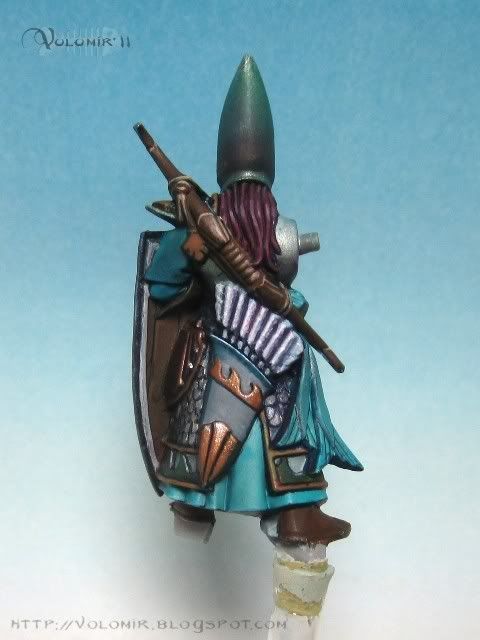
But notice how the braid in the front was painted. Look at the shiny spots.

Leather is also a very entertaining thing to paint. Working with textures lets you be less worried about smoothness because you paint dotting all over the surface with different colours until you are satisfied with the results. Look at this process on a glove.
First, basecoat of plain Chocolate Brown (Vallejo).
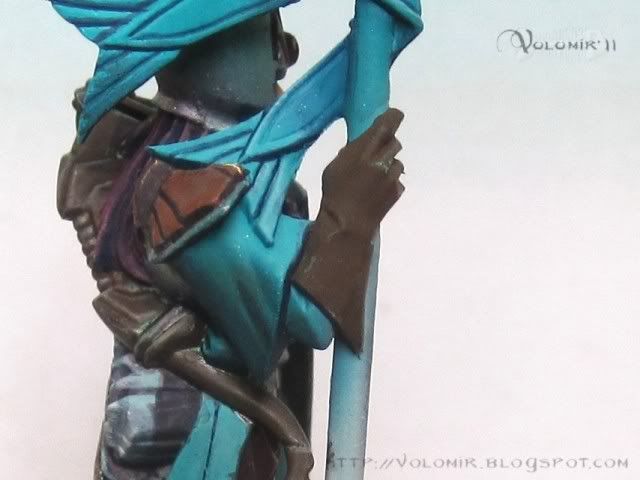
First lights with English Uniform (Vallejo).
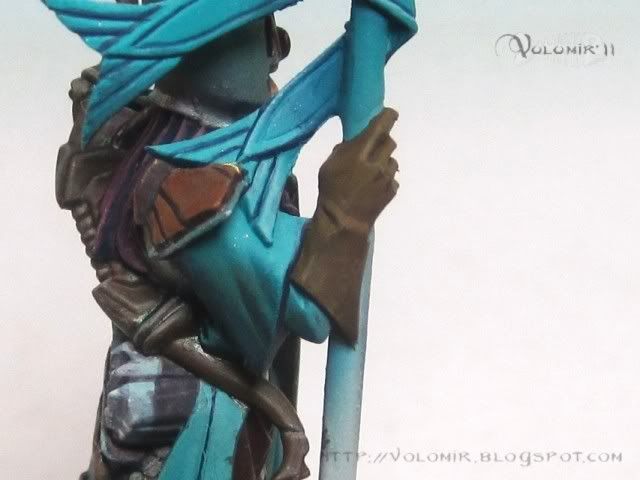
Second lights adding a bit of Ice Yellow (Vallejo) to the English Uniform.
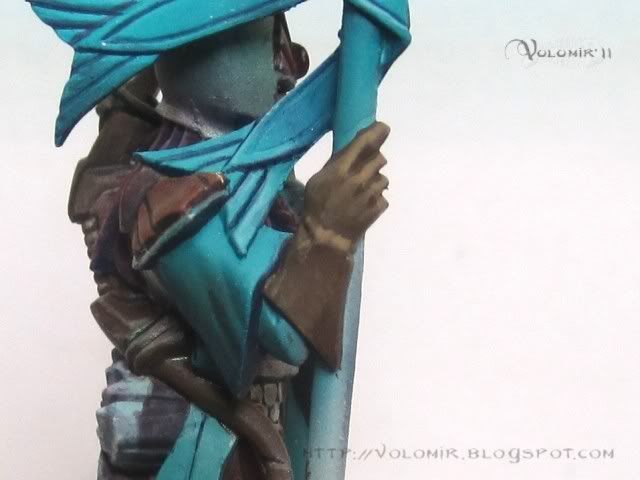
More Ice Yellow to the mix:
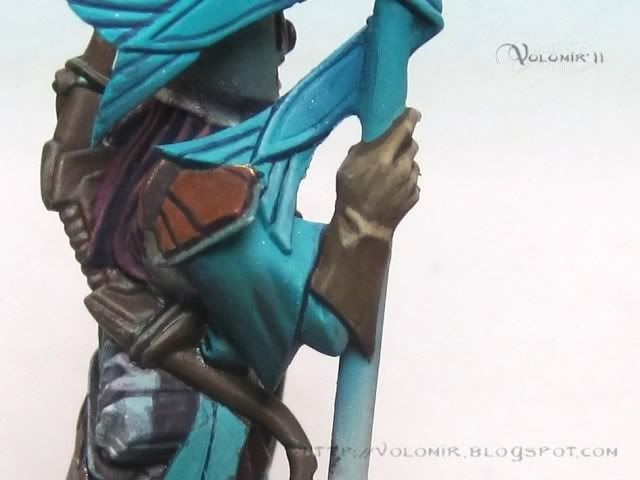
Final light points adding white to the mix.
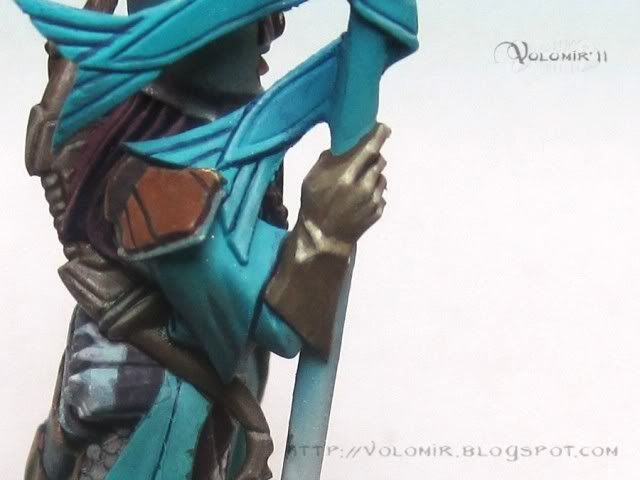
First shadows with some brown with more red, like Number 6 from Andrea's Flesh Paint Set.

Deeper shadow adding a but of blue.

Let's start now with the work on the banner.
First of all, we need to have a clear thought of what the design of the freehand will be. I will create a design of my own on GIMP (freeware Photoshop) following the tutorial I wrote here.
And here's my creation for this time.
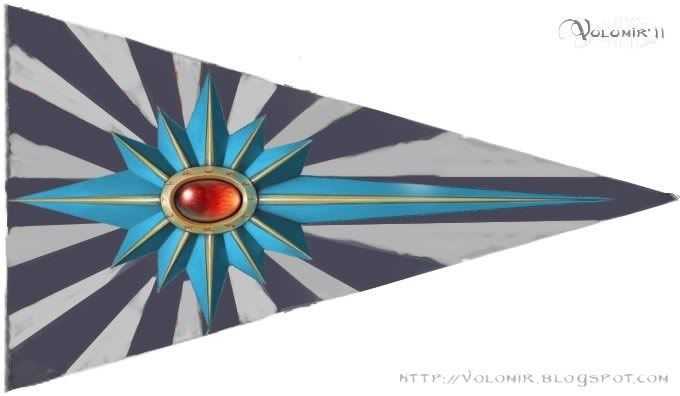
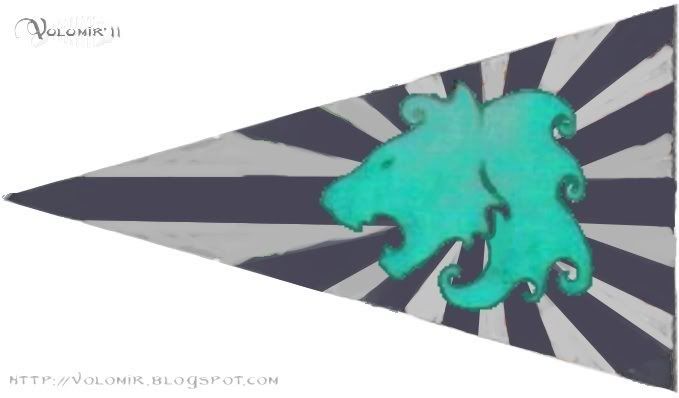
As you can see, I tried to maintain coherency with the motifs found in the prince of Tribute to the Fallen. Basically, we are talking about the star from the High Elves, the colours in the background, and the lion motif of the back. Its a pretty simple design.
With the design done, I print it in the exact size of the banner.
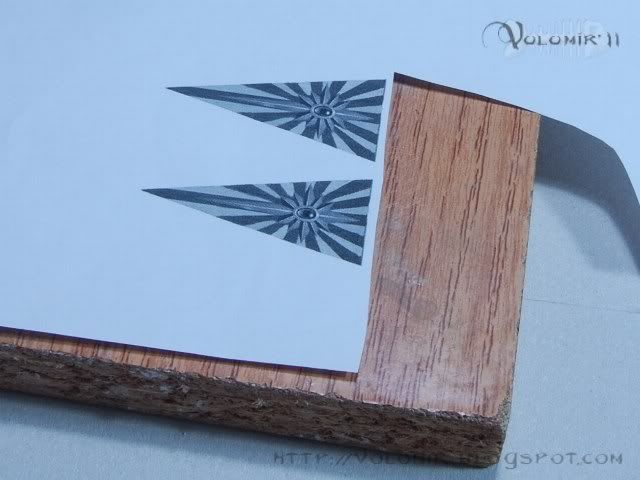
I cut and paste the banner design to an airbrush template.
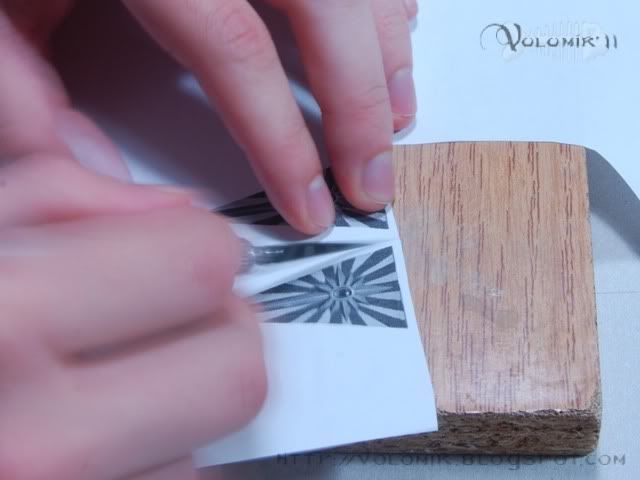
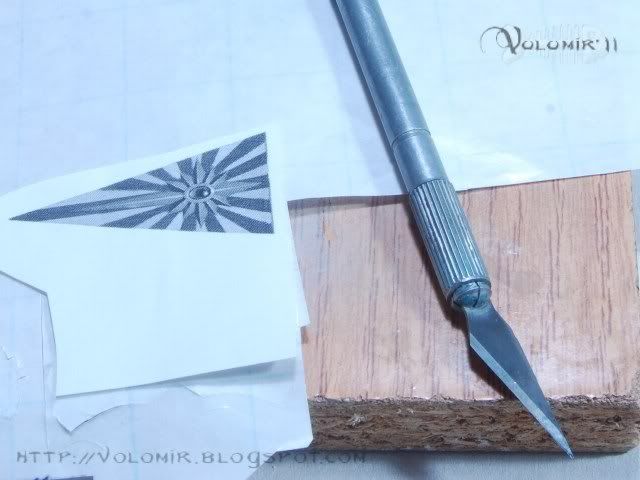
Now I need to cut the different shapes of the design. Remember you need to divide the banner into different simple shapes which will be the ones you'll airbrush, and all the detailing will be done with a normal brush. So I divided this banner in three different areas. The first one would be the central motif, which in the front part is the whole star, and in the back part is the lion head. The second part is the area covered by blue stripes and the third part is the area covered by the grey/blue striples.
So that's what I'll do now. I will cut the star shape, and also the shape of one of the colours of the stripes. The other stripes will use the colour which I will airbrush as background of the other. Take a look at the photos because the process is easier to be seen than to be explained.
Cutting out the star from the airbrush templates.
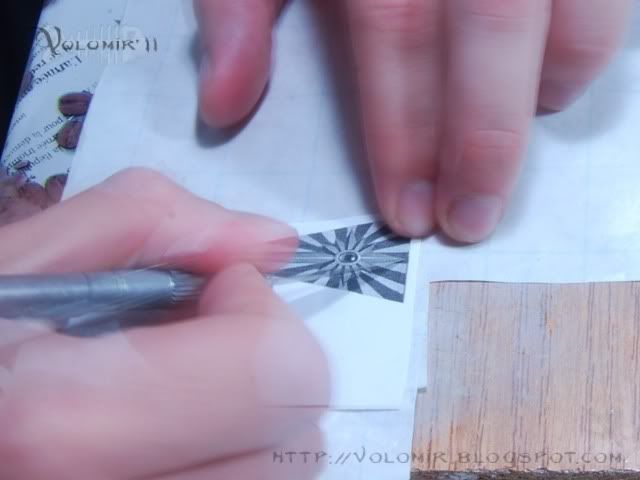

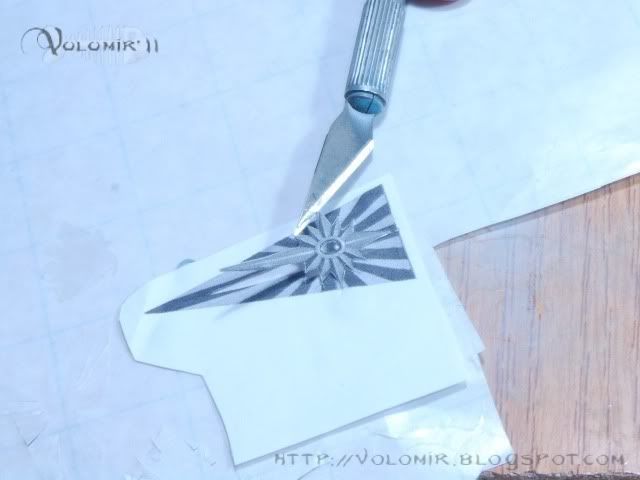
This is what we end up, its a transparent template, thats why its difficult to appreciate it in the photo.
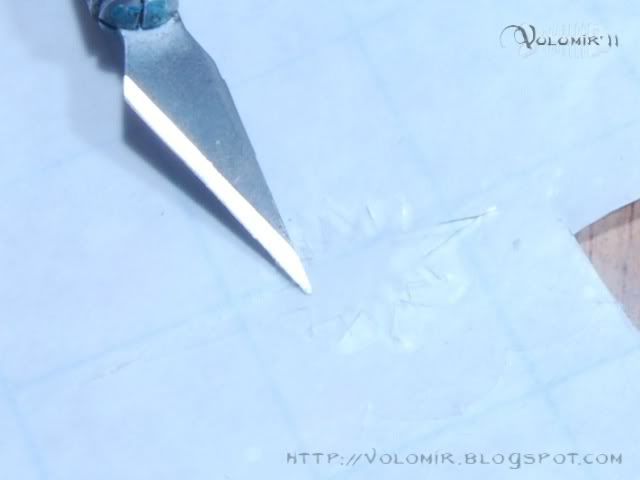
I need to do the same with one of the colours of the stripes. Doesn't matter which one of them, but take that choice into consideration when colouring the background of the stripes later. I also need a template for the lion head.
Now that I have all the templates, I prime the banner in white, Gunze Sangyo airbrushed.
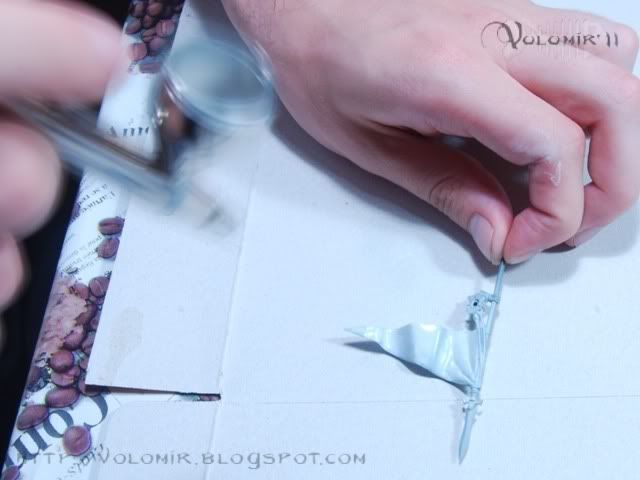
Then I airbrush the whole banner with the turquoise blue of the star and the lion head. I could have primed directly in this turquoise, but I wanted the extra resistance which the Gunze Sangyo white priming gives me, and then give the base in any other colour.
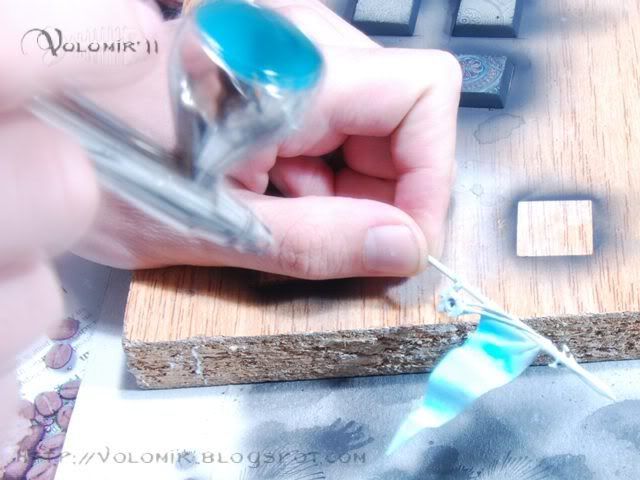

I put the template of the star on the banner.
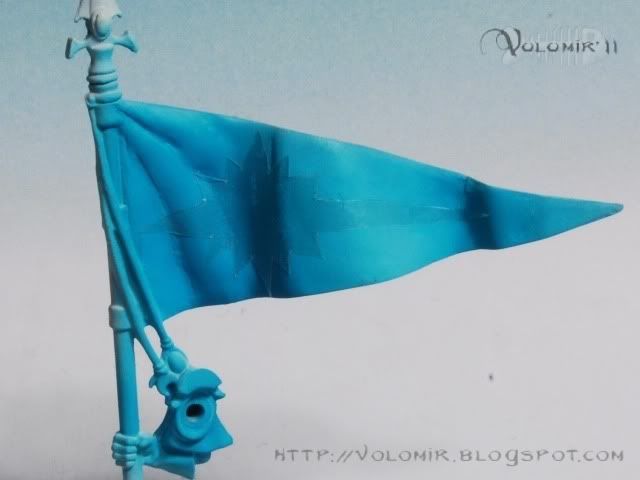
And I airbrush with one of the colours of the stripes. This will be the background colour of the other stripes. I previously cut out the shape of the white stripes, so that's why I now use the other stripes colour as the background.

Same with the back part of the banner, but in this case, I airbrushed turquoise, then put the lion head and then airbrush the blue of the stripes.
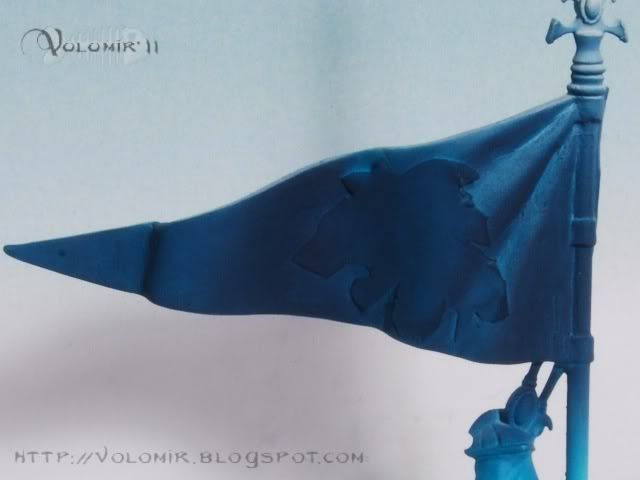
Now I put on the shape of the white stripes.
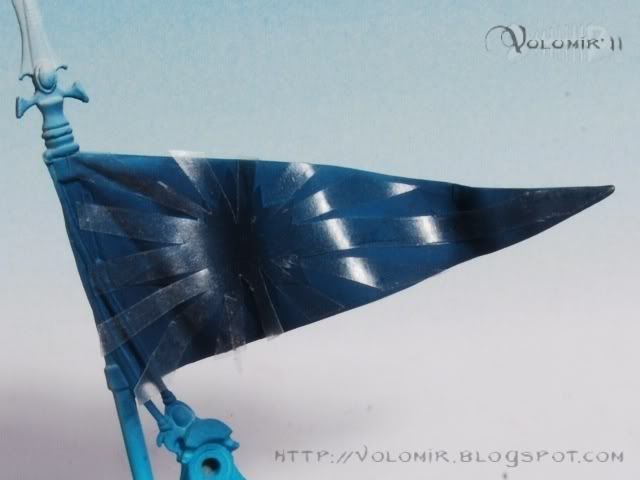
And prime in some king of ochre, Conferedate Grey from Andrea Colour.

The same in the back part. And then it's time to retire all the templates! Let's see the overall effect on the standard bearer.

Detailing the banner! This is a much more artistic process, I can't think of the most efficient approach in terms of time. Just have some happy painting time and enjoy. Using the freehand tecnique, I will try to make the motifs as similar as possible to the original design I made in GIMP.
First of all, I paint the gem in the center. I could have separated the gem as a different shape in red and done its painting with the airbrush. It would have probably been easier and faster but I realized it later, so it doesn't matter. Then the first shapes inside the star.
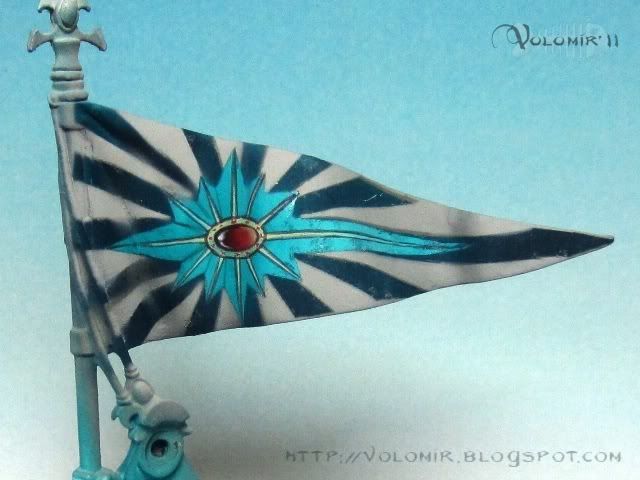
Be patient and enjoy, it's not as difficult as it may seem, and it's very fun! Shadows on the arms of the star, and also fixing of the stripes in some areas:
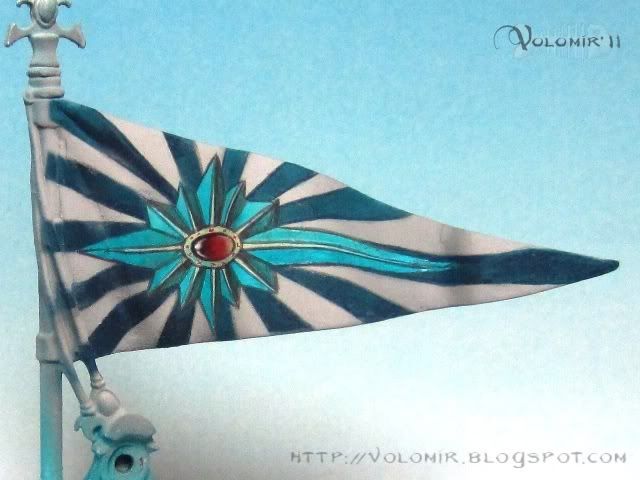
Same to the back of the banner. See the outlining of the lion head in process.
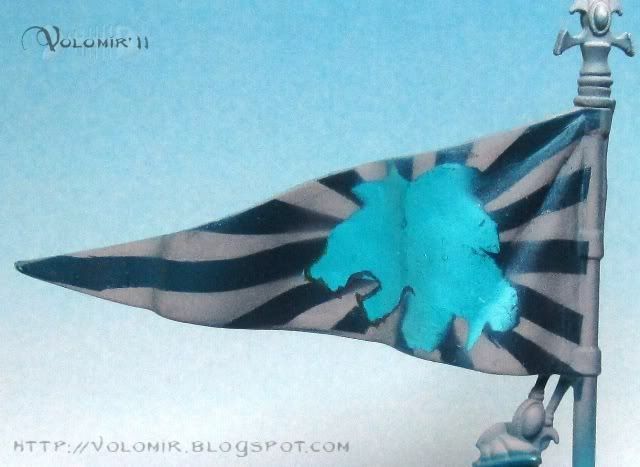
And now that I have more or less the design finished, I use the airbrush to give general shadows to all the flag, which will help maintain the ambience and give coherency to the whole banner.

Same to the back.
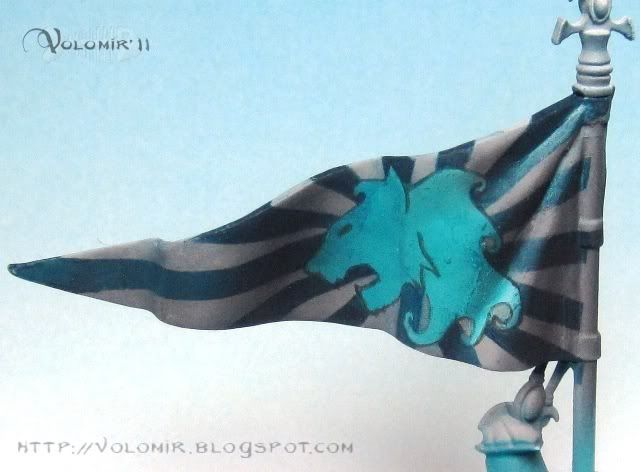
Finally, there are only minor details left to be painted on the elves, such as the wood on the spears, and other stuff which I have already explained.
And so thats it! Check out the final results here.

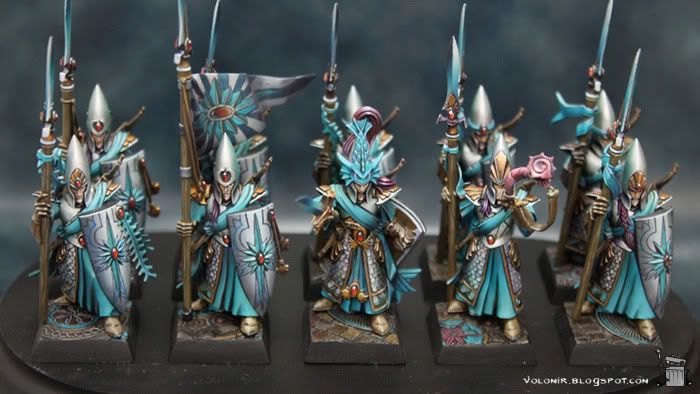
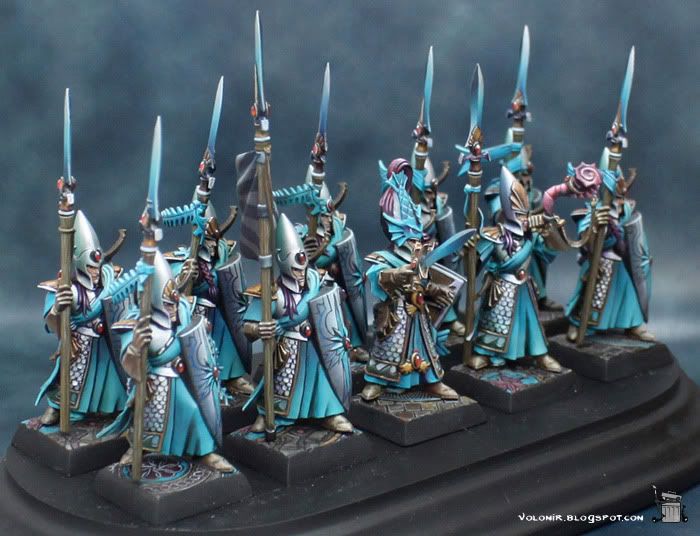
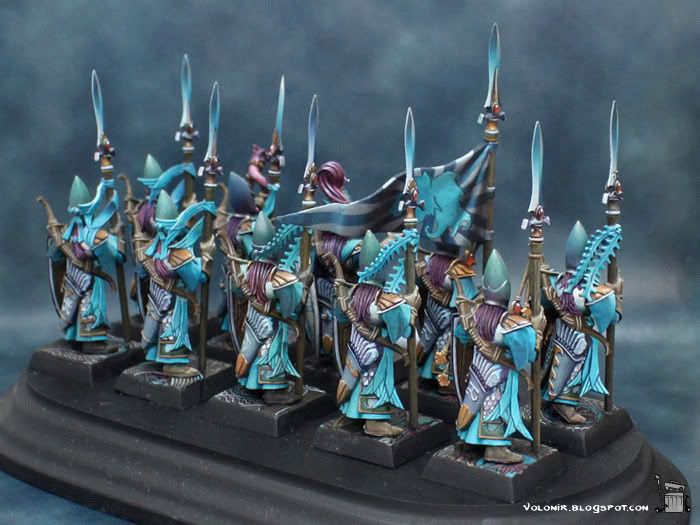

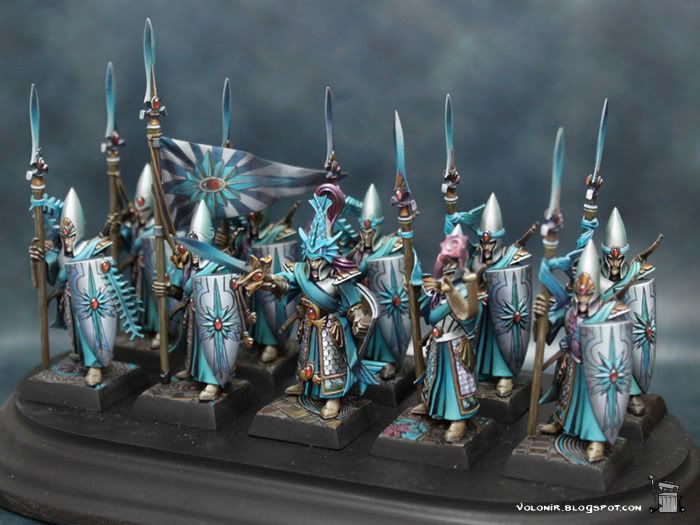
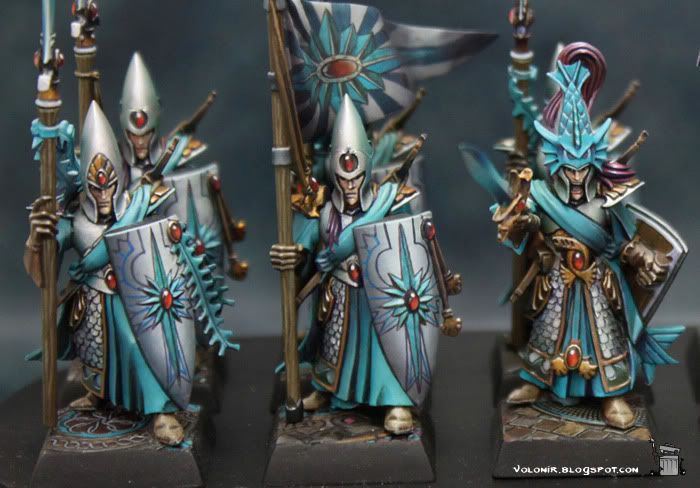
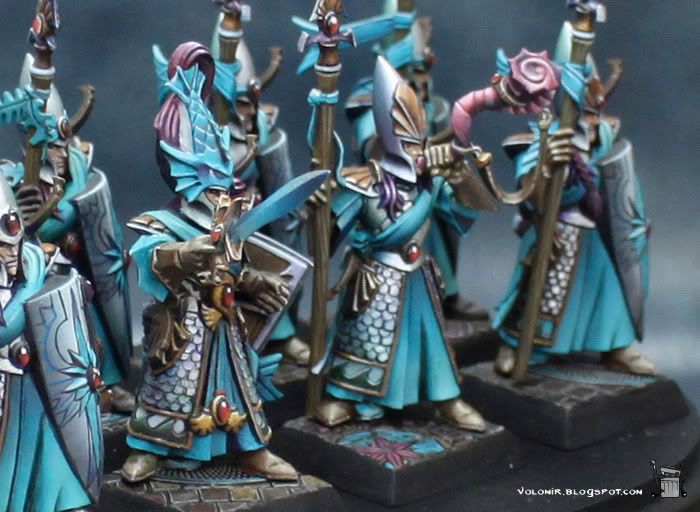

19 comments:
Great tutorial. Thanks for posting.
Excellent tutorial, I learnt a lot just reading. Well, I'm sure now that such kind of painting is well beyond my abilities, even though I have airbrush.
Bravo, Sir!
Awesome regiment. Gold at the Golden Demon is very fair. :-)
I think I've to buy an airbrush now...
They are great!
Great tutorial Volomir. I have a question though. What size nozzle do you use in your airbrush for such fine detail work?
Thanks everyone! You really make my day with such kind comments.
@Vinny: the nozzle I use is 0.4. I don't think you will get a finer trace if you use something smaller, and you will have higher risk of clogging the nozzle. Using 0.4 is my reccommendation!
Thanks man! I think I'm using a 0.5 one at the moment. That might explain why I find it hard to do anything but basecoat with it!
I also need airbrushing practice though but I got some great tips from this article, so thanks again!
@Vinny: I've never used a 0.5, but I'm sure you should be able to do the same work as I do with my 0.4, you just need practice! Well, also being given some quick lessons helps a lot XD but I'm afraid I'm too far away to help with that, I'm still investigating teleportation as a form of transportation but meanwhile I'm stuck in Madrid!
Beautiful models and congratulations on winning Gold!! I'm a High Elf player and I'm about to start painting the same models. Your tutorial will serve as a great guide and inspiration! I'm looking forward to seeing the rest of your High Elf army. Thanks for posting and sharing your talents.
HH
Lol, and I'm stuck in Ireland! I'll have to make do with pictures and words in the long run!
Amazing work mate, just amazing.
Just found this browsing my new favourite blog! Seriosly the painting is off the wall and the tutorials are somethign else all together - I am very keen to do some freehand paiting with my airbrush now as well!
What material do you use to make the airbrush templates? And where do you get it from?
I visited Madrid last Easter - wonderful city but too much to do in a short time! Next time I visit I will be sure to book some lessons! :-p
Hey Lloyd!
Thanks for the kind words! I'm glad you like it :)
The material is called exactly like that: "airbrush templates". I buy them at a local arts and crafts store here in Madrid. Let me know if you happen to visit Madrid again!
:D
Hi Rafael
Thanks for your response! A quick browse of the internets and I can't see any templates - not to worry however I will come up with something!
I have so many questions that I'd probably drive you crazy, so I think the best thing i can do is just order some Sea Guard and try and mimc the look you have got :-)
I also have a Harald Deathwolf banner I was planning to do so will maybe try out yourtechnique for that!
Cheers
Lloyd
Ok this maybe by far one of the best and most detailed Step by Step tutorials on painting a unit that I have ever seen!
Touche!
Thats amazing work :-)
What airbrush do you use? is there a link where I can buy one?
I was looking to buy one after seening one in action an yours is amazing.
Hi Jo, I use Harder&Steenbeck Evolution 2in1. I believe you will be able to find it in many stores wherever you live, but you can also check this website: http://www.germanairbrush.com/
What a great WIP! And teh end result is excellent!
Greetings
Peter
Post a Comment